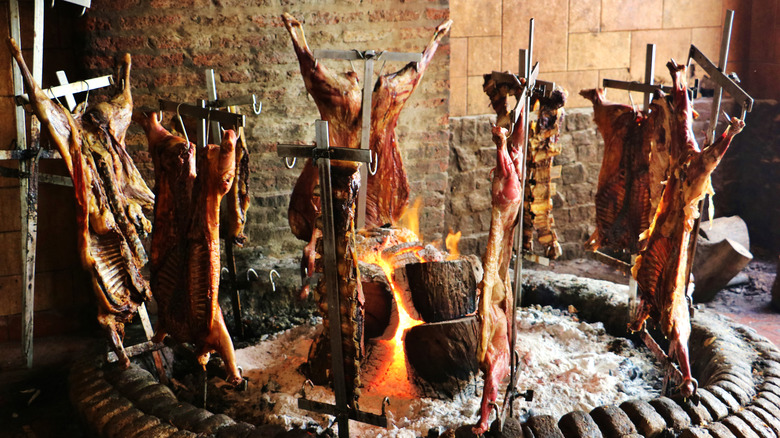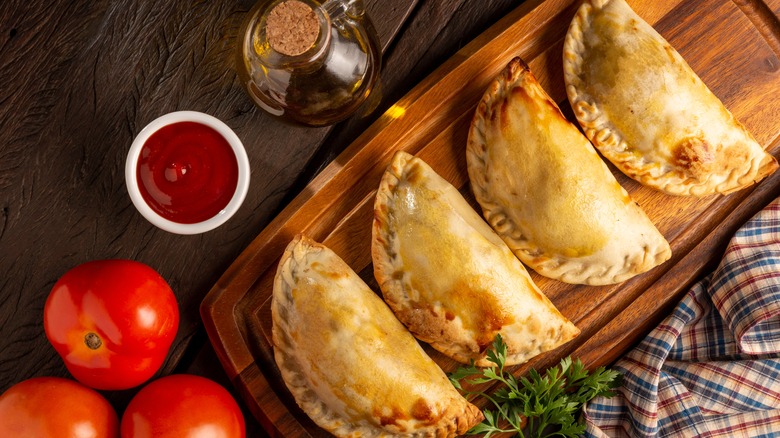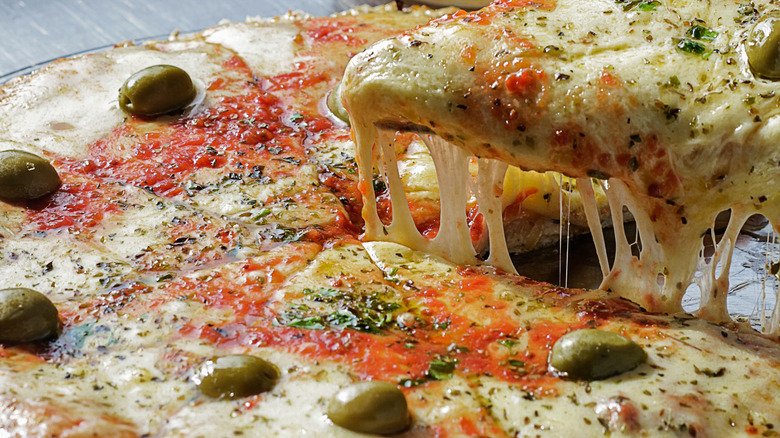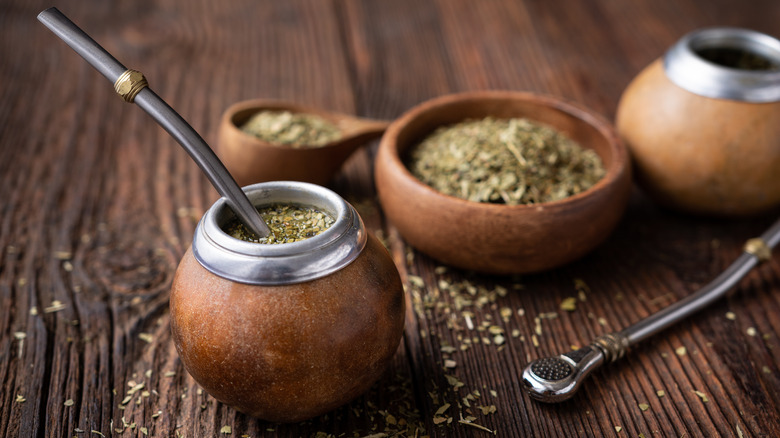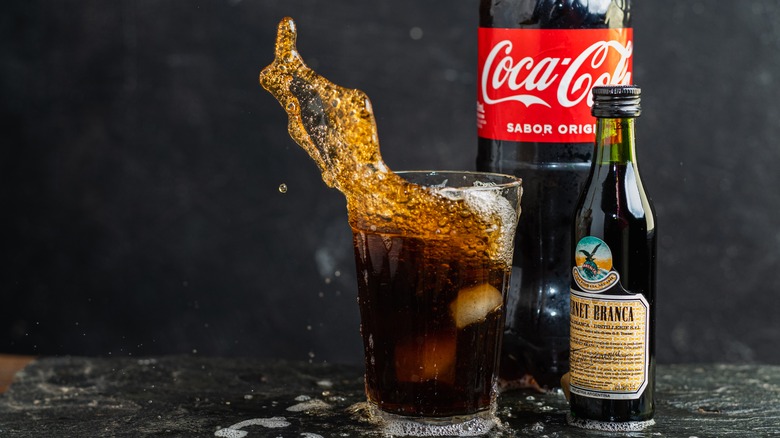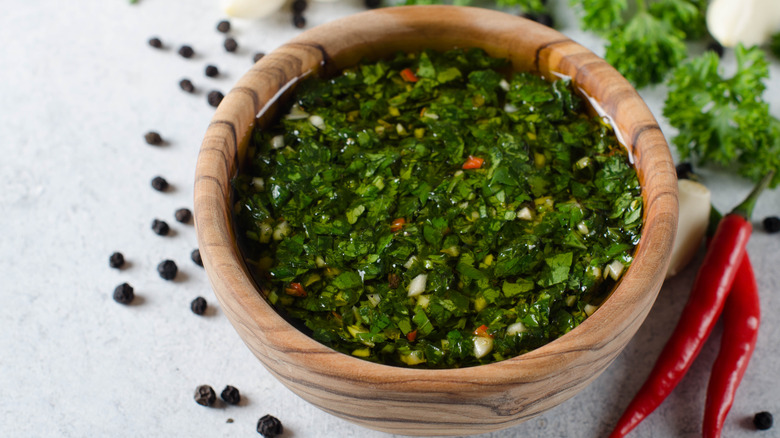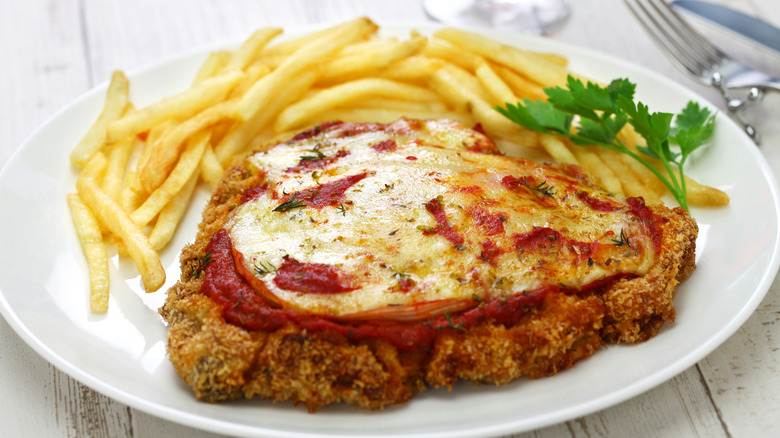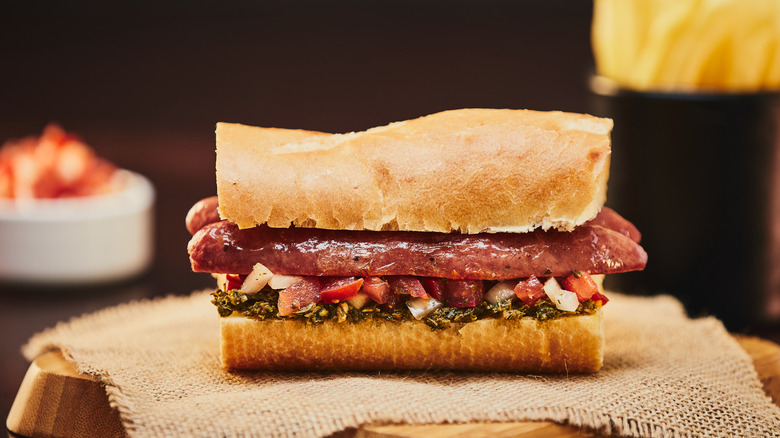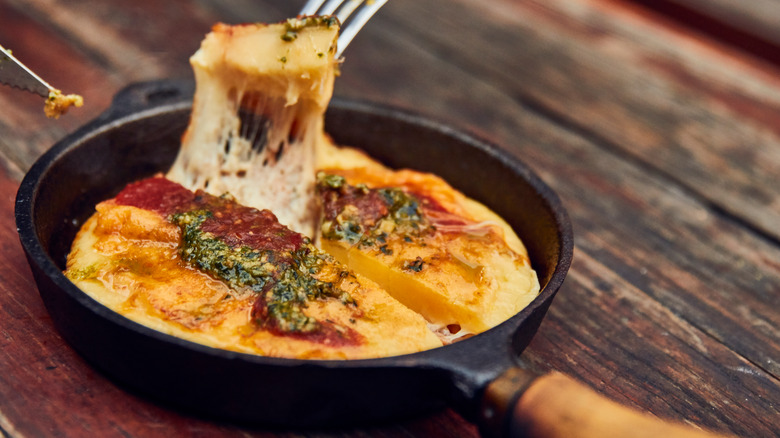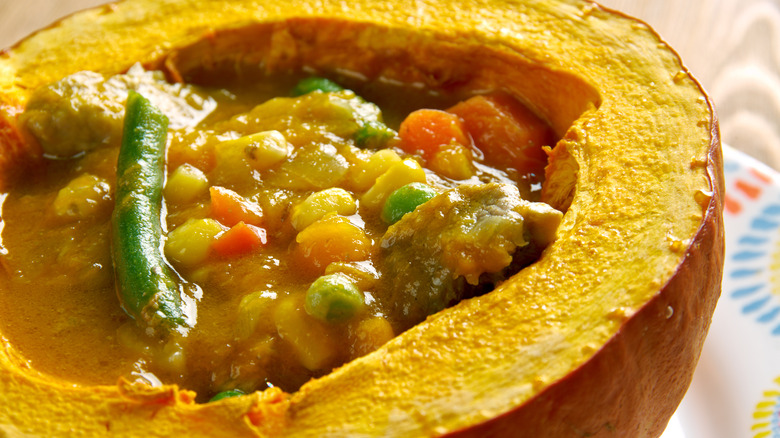14 Argentinean Dishes You Need To Try At Least Once
Argentina is best known for its steak, wine, and recent World Cup championship. While plenty of beef and booze was consumed to celebrate the nation's recent athletic success, visitors to the South American country will discover so much more than a glass of Malbec and a cut of cattle.
Now, if you're abashed to eating meat three times a day, or are a staunch vegan, Argentina probably isn't the food destination for you. Like a visit to Japan without consuming noodles, it's difficult to truly experience Argentine culture without having at least one bite of beef. The cattle industry simply has that kind of importance to the country. When the Spanish were busy pumping silver out of Bolivia and Peru, gauchos were herding cattle in what would eventually become known as Argentina. Cuts of beef truly are as historically important to the nation as the tango and Messi. So, whether you're looking to explore Argentina through its food, or you want to try and craft some of the food back home, here are several Argentina dishes you absolutely need to try at least once.
Asado
Asado is an Argentinian cookout. But the meat here is cooked differently. You would never think about putting the meat over charcoal, and using a gas grill would be absolute sacrilege. Instead, meat is very slowly cooked over wood embers. Pro tip: If you're visiting Argentina, locals typically cook their beef well done, so if you still want some pink and moisture, make sure to request it that way.
Now, the very best way to experience an asado in Argentina is to attend one being put on by a family member or friend. These are often all-day affairs. There is even a specific order in which the meat is prepared. Organ meats (if they are to be consumed) and sausages are made first, almost as an appetizer, before the rest of the animal is prepared. So, yes, you absolutely are about to eat chorizo, and morcilla (blood sausage), before eating even more meat. It is also very possible you won't see anything green outside of the chimichurri sauce (more on this later).
Alfajores
You can't go to any convenience store, any drug store, or really any shopping center at all in Argentina without coming face to face with this dessert. There are a handful of variations, but typically there are two soft, circular cookies with caramelized milk (known as dulce de leche) in the middle. It is then usually coated in milk chocolate (although dark chocolate and a white frosting are both options as well).
The true trick in enjoying the sweet shortbread alfajores is to find out which brand is worth eating, and which is better left on the shelves. Because the flavors themselves are similar, it all comes down to the quality of the ingredients. Ask around, and the majority of locals will tell you Havanna sells the best (Havanna is kind of like an Argentine Starbucks but with its own display of various chocolate goodies). Boxes of alfajores can be purchased at Havanna, both in local shops and at the major Buenos Aires airports (so if you forgot souvenirs for family members, don't fret, the Duty-Free Shop will have you covered).
Empanadas
Although most nations have their own versions, Argentina's empanadas are very straightforward. The dough is baked (not fried, like in other countries in the region), with usually ground beef, shredded chicken, or ham and cheese center.
You could probably write a very interesting college dissertation about the history and cultural importance of empanadas. The exact time and place of its invention is not known, but then again it's basically dough wrapped around some kind of meat, which was typically done to help extend the life of the meat. However, it first appeared in a cookbook dating back to 1520 titled "Libre del Coch."
In Argentina, the empanadas can take on slightly different flavors and appearances based on where you are in the country (interesting enough, the folding techniques will often change based on where you are). In Buenos Aires, the most common empanada looks like a mini calzone, with the curved end pinched off. But in other locations, the dough will be folded in on itself, while others will have more of a spherical shape.
Argentina pizza
A large portion of Argentina's population, specifically Buenos Aires, migrated from Spain and Italy, so there is a great deal of Italian and Spanish influence on just about everything. Argentina pizza is very similar to the Italian Neapolitan style. However, the cheese in Argentina is slightly different, so if you're coming from the U.S., just keep in mind that you're not going to have the exact same cheese taste. This is true even if you're ordering a pizza that uses mozzarella. It is important to go in not expecting the exact same taste you're accustomed to because you're not going to find it — and the whole point of traveling is to try new things anyway.
Additionally, the most common cheese used on pizzas in Argentina is referred to as queso, which can be a bit frustrating for outsiders, as queso translates to cheese. Don't worry, it's not any random cheese, but instead, it is a creamy white cheese. Because it is white, you wouldn't be the first (or the last) person to assume it is mozzarella, but instead, this cheese will taste very different and is so thick that cutting your slice with a knife and fork is probably a good idea.
Yerba mate
While not a food, mate is such an important part of the Argentina culture it is absolutely a must to include. You'll see individuals sipping on open-faced, circular cups with an interesting, compacted "tea" like herb packed into it. This is mate, and it is a naturally caffeinated herbal drink. Essentially it is tea, but don't call it that. The cup itself (the mate gourd) is called mate, and the straw is called a bomba. In Argentina, it is always served hot, although, in other countries, like Paraguay, it is served chilled.
Yerba mate is one of the things you'll find that doesn't have a direct European history. During a visit, you will see many locals walking around not only with their gourd and bomba straw but with a thermos wrapped around their shoulders as well. With such a strong dedication to the drink, you owe it to yourself to give it a try.
Fernet and Coke
Another beverage cocktail that absolutely needs to be covered in order to take in the full Argentina culinary experience, the official Argentina cocktail is fernet cut with Coca-Cola. This is basically Argentina's version of rum and Coke. However, fernet is an interesting liquor that originated in Italy. It has an herbal meets black licorice that meets menthol taste to it (in our opinion, mix it with a lot of Coke). If you are a fan of Jäger, you'll probably like Fernet, as the two share similar tastes.
Just how much do locals love drinking fernet? The main brand in the country is Fernet-Branca. It is an Italian company that has been producing its drink since the 1840s out of its headquarters in Milan. Because the drink is so popular, the company opened a new manufacturing facility in Argentina. In fact, Argentina makes up for 75% of all fernet consumption in the entire world, notes CNN. So, give it a try, although as we said earlier, mix it with as much Coke as possible.
Malbec wine
The last beverage we'll include on this list is Malbec wine. Argentina is a major wine producer, and while in Argentina, you're going to be hard-pressed to find wine from any other country on the planet that isn't named Argentina. One major reason behind this is that local wine is incredibly inexpensive. You can get a quality bottle of wine for the equivalent of $2 to $3 U.S. dollars. Malbec is the wine of choice produced in most of Argentina.
What exactly is a Malbec wine? Let's dive into it in case you're not familiar with the wine type. For starters, Malbec wine is produced using Malbec grapes (which makes sense). Malbec is almost exclusively grown in Argentina. There are a few wines that can be found elsewhere, but it very much is dominated by the country. A Malbec wine usually has a dark cherry, plum taste, with some hints of spice or even vanilla, although the latter notes are dependent on if the wine is aged in new barrels. The tannic levels are anywhere from the middle range up to a much more dominating presence.
Fugazza
We're back to food and we're back to pizza. This is such a unique Argentina food that it deserves its own slide. Fugazza is your standard pizza, but the top is covered completely in shredded sweet cooked onion. As in, there's no space between the onion slices. The sweetness of the onion goes surprisingly well with the salty cheese. If you're an onion lover, this is an absolute must.
Fugazza has been served in Argentina for around 100 years. What is truly fantastic about the pizza, though, is you can actually stop by the restaurant where it was first invented. Banchero's, named for Juan Banchero, is located in the La Boca neighborhood of Buenos Aires. You might better know La Boca for Boca Juniors, which is one of the main fútbol clubs in Argentina (Diego Maradona played for the club). The neighborhood can be a little rough around the edges, especially once you move away from the touristy area, so if you head out either do so with locals you know or try the fugazza pizza during the day.
Chimichurri
Much of the food you find in Argentina has a direct connection with Spain or Italy. Chimichurri sauce, however, is very much an Argentina creation. You can find other variations of this sauce in other Latin American countries (there is a chimichurri in Bolivia, but that is closer to an avocado salsa found in Mexico), but the name and sauce originated in Argentina as an olive oil-based sauce that uses garlic, oregano, onion, and usually a hint of vinegar or lemon. Local recipes will call for "chili pepper," but this is very, very different from the chili pepper found in North America. It is closer to your standard garden red pepper. While Argentina's cuisine is many things, spicy is not on the menu.
Chimichurri is a common dipping sauce used for just about any meat offered in the country. From cuts of steak to chorizo, you will find it everywhere. We recommend keeping it handy, just in case you forget to ask for your steak to be cooked medium-rare and it comes out darker than burnt toast.
Milanesa
Milanesa is a very thin cut of beef coated in an egg batter and deep-fried. Think of it kind of as a chicken-fried steak, but much thinner (and the batter is usually lighter as well). This dish is technically Italian, but it is such a popular meal in Argentina it's necessary to mention it (most of the dishes here are technically Italian or Spanish, but Argentina has made them their own).
If you want to eat like a champion, you might want to consider ordering milanesa. Lionel Messi swears by the dish and considers it his favorite meal (although he prefers the fried chicken version over the fried beef). While you might feel like taking a nap after eating the breaded and fried cut of meat instead of running around for 90 minutes (plus stoppage time, of course), it's a carb-heavy food that'll likely leave you satisfied — especially when it comes served with its own side of french fries and topped with a tomato and cheese sauce.
Medialuna
This is Argentina's take on the croissant. However, the Argentina medialuna version is sweeter. There is a subtle sugar glaze applied to the top of it, and it is a breakfast pastry, although you'll also find sandwiches made with it.
The medialuna name, which basically translates to a half moon, is shaped like its cosmic namesake. Some medialunas will be wide and fluffy, while others are very, very skinny. It really comes down to where you are buying them from. Most restaurants and cafes have their own variations, so while visiting Argentina you will never be far from a medialuna. As these are served with a morning cup of coffee, you can take the medialuna as a replacement for the classic doughnut, although the sugar glaze isn't as intense as a pink frosting and sprinkled doughnut is. But don't you worry, with The Simpsons being so popular in Argentina, you better believe you can find the standard Homer Simpson doughnut around town, as well.
Choripán
This food is in the same category as the empanada. It has its origins in Spain, and many countries in Latin America have their own take on it. Calling it specifically an Argentina dish would be false, as it is commonly consumed in countries like Peru and Bolivia, as well. This particular dish in Argentina is all in the name. It uses chorizo (sausage) as the meat, then stuffs a kind of bread (pan) to give you a nice sausage sandwich. It's basically Latin America's own version of the bratwurst on a bun.
The best way to enjoy a choripán sandwich is right off the grill. The sausage will come off the grill still dripping in its own juices, and then either be cut in half or sliced prior to its addition to the bread. This preparation is similar to other countries in Latin America, although it's really the sauces that differ. In Argentina, it is again typically going to be a chimichurri sauce, whereas, in countries like Peru or Bolivia, you have spicier sauce options.
Provoleta
If you've ever been to a Greek restaurant where they bring out the flaming cheese, provoleta isn't far off. While nobody is going to yell "Oppa!" when they place the cheese down in front of you, this is a grilled slab of cheese served as-is and can be consumed with just your fork.
This particular kind of cheese is rather unique, though. Natalio Alba, the man who invented the cheese back in the 1940s, wanted to craft a cheese that could be grilled, would become soft in the middle, and yet wouldn't melt into a stringy mess when placed over heat. Now, the melted cheese dish provoleta is served along with most meat dishes. The cheese was even trademarked back in 1963. The real difference with how the cheese tastes though is the seasonings applied over the top when served. Although, even these seasonings are generally similar from one restaurant to the next, with a blend of oils, oregano, and garlic. Make sure you arrive at the asado with an empty stomach, because you're going to love the meat, cheese, and wine.
Carbonada criolla
This is an Argentinean stew. It is typically served in the Northwestern region of the country (as well as in the Southern, Patagonia area of Argentina), up along the river where the country connects with Paraguay and Brazil. You will find similar dishes to this stew in the neighboring countries, as well. This is more of a regional dish with ingredients including corn, squash, potatoes, and beef.
If you really want to enjoy this dish in the most authentic method possible, you will want to track down a restaurant that serves carbonada criolla directly out of a hollowed-out pumpkin. The ingredients, which are added to the pumpkin, are then buried under wood ash and left to cook for several hours. This infuses the stew with a hearty, gourd taste to it. The pumpkins used are a bit different from the Halloween pumpkins you are familiar with, but the taste is similar. You will have better luck tracking this kind of stew down in the Patagonia region, where the winters are longer and colder, so hearty stews are a popular dish.

